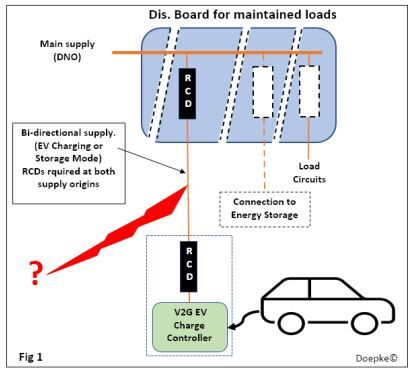Chaz Andrews Doepke Technical Manager – Outlines key points and selection possibilities when connecting RCDs in series for EV installations.
722 Amendment 2 – Design Rules
The IET Code of Practice (CoP) for EV Charging Equipment Installations 4th Edition gives detailed design requirements. Effective and safe design solutions for a specific installation relies on the correct interpretation of the rules e.g., 722.531.3.101 Amd 2 referring to 30 mA RCDs; “each charging point shall be protected by” It does not state that the RCD must be in the chargepoint – see Note 3. In Domestic installation with a single Mode 3 charge point, if the design requires a 30mA RCD upstream (see CoP clause
5.6.2), an additional RCD in the chargepoint adds to the operational complexity. However this does not apply to PEIs (Prosumer Electrical Installations) containing a V2G (Vehicle-to-Grid) or V2H (Vehicle-to-Home) feature i.e. if the vehicle is providing storage – see CoP for EV Charging Installations section 10 and CoP for Electrical Energy Storage Systems section 9: A supply cable requiring 30 mA RCD protection, with the potential to be fed from either end, requires two 30 mA RCDs to ensure disconnection in the event of a fault related to the cable connecting the V2G Controller to the distribution board.
Reference CoP EV Charging Installations section 10 Fig9.8 page 86; based on vehicle to grid / grid to vehicle operating mode, location of the fault and the existing installation rules relating to disconnection times for fault protection. The CoP for Electrical Energy Storage systems Table 9.4 page 98: Specifies safety selection requirements for Types of RCD used in circuits containing Bi-directional inverters. This is applicable to Fig 1 V2G charge controllers.
Consider the guidance given in the associated IET CoPs for safe installation designs, before deciding on the final design of the installation. With innovative technologies the “State of the Art” is an important concept to consider in relation to COPs and the year of publication. Designers require sufficient and appropriate experience to consider existing advice and any additional available information relating to safety issues, design, and equipment / system developments when working with innovative technologies.
Different Types of RCD in series
722.531.3.101 Amd 2 Note 1 refers to Regulation 531.3.3; detailing the requirements for selecting Types of RCD, based on the nature of the residual currents e.g., DC components and frequencies flowing through the RCD. In Fig 2, the combined residual currents produced in the downstream circuits will flow through the upstream RCD. In this example iFDC would exceed 6 mA up to 12 mA, before one of the chargepoints outputs disconnects the faulty load. BS 7671 531.3.3: Type B RCD required upstream of two or more chargepoints, as the combined d.c. leakage current can exceed the limit for Type A or F RCDs.
Selectivity
In addition to the RCD Type, consider the requirements for Selectivity when installing RCDs in seriesspecifically regarding the continuity of supply to other RCD protected services. See CoP Fig 8.1 chargepoints located inside and 8.2 for chargepoints located outside, with the upstream RCD providing fault protection.
The product standard BS EN 61008-1 Table 1 specifies a minimum non actuating time of 50 ms* for Selective RCCBs, represented graphically in Fig 4. Comparing 30 mgeneral delay and 300 mA selective delay RCCB characteristics; the 10 ms difference (50-40 allows full selectivity. Using 100 mA, 100 mA “S” or 300 mA upstream of 30 mA may only achieve partial selectivity under certain residual current fault conditions.
Conclusion
Check the EV Manufacturer’s chargepoint specification for specific RCD requirements and any additional equipment requirements to meet BS7671. For smaller installations containing multiple chargepoints, it may be cost effective to consider a design using individual feeder circuits with separate RCDs for each charge point. For more complex installations with existing RCD protection on the main incoming supply, consider the design carefully e.g., RCDs, Type and sensitivity already installed, selectivity, possibilities for a separate supply cable. Refer to the revised Code of Practice for EV Charging Equipment Installations 4th Edition and Amendment 2 of BS7671. Equipment that fails to at least meet the existing regulations, will not provide the expected level of protection. For further information on RCDs please refer to the Doepke Web Site Product selection pages and Download pages.
Chaz Andrews – Technical Manager, Doepke UK Ltd
sales@doepke.co.uk or www.doepke.co.uk





